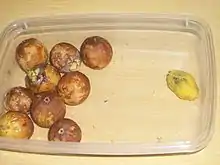Syagrus cearensis
Syagrus cearensis (Portuguese: coco-babão) is a natural palm endemic to Brazil.
| Syagrus cearensis | |
|---|---|
 | |
| Appearance of the fruit | |
| Scientific classification | |
| Kingdom: | Plantae |
| Clade: | Tracheophytes |
| Clade: | Angiosperms |
| Clade: | Monocots |
| Clade: | Commelinids |
| Order: | Arecales |
| Family: | Arecaceae |
| Genus: | Syagrus |
| Species: | S. cearensis |
| Binomial name | |
| Syagrus cearensis Noblick | |
It is native to the states of Piauí, Rio Grande do Norte, Paraíba, Pernambuco, and Ceará[1][2] Its highest rate of occurrence is within Ceará state, used in the species iname.
In the state of Ceará, it occurs in environments of Atlantic Forest and sandbanks, and also occurs in the transition to "Caatinga scrub, and on the slopes of the plateaus.[3]
It is very similar to the species Syagrus oleracea, but is distinguished by the fruit, which has yellow flesh while S. oleracea has predominantly green fruits even when mature, and also S. cearensis has habit of growth in clumps, rather than the upright growth of the other species. Its fruit is a yellow fibro-mucilaginous drupe with a sweet taste, which is often sold in street markets in their places of origin.[4]
References
- Kew World Checklist of Selected Plant Families
- Noblick, Larry Ronald. 2004. Palms 48(2): 73–76.
- Forzza, R. C. 2010. Lista de espécies Flora do Brasil http://floradobrasil.jbrj.gov.br/2010. Jardim Botânico do Rio de Janeiro, Rio de Janeiro
- Lorenzi, H., Noblick, L.R., Kahn, F. & Ferreira, E. (2010). Brazilian Flora Arecaceae (Palms): 1-268. Instituto Plantarum de Estudos da Flora LTDA, São Paulo, Brazil.
![]() Media related to Syagrus cearensis at Wikimedia Commons
Media related to Syagrus cearensis at Wikimedia Commons